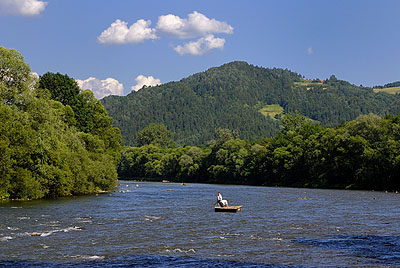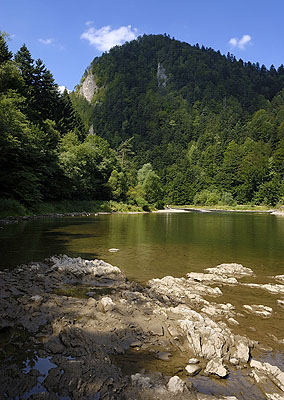Dunajec river
 The Dunajec is a right-bank tributary of the Vistula River. It is formed near Nowy Targ at the confluence of the Czarny Dunajec (Black Dunajec) and the Biały Dunajec (White Dunajec). Nowy Targ lies within this bifurcation. The Czarny Dunajec is formed as a consequence of the merger of two streams (Chocholowski and Koscieliski) which rise in the Tatras. Biały Dunajec is formed from many similar Tatra streams: Cicha Woda, Strążyski, Bystra, Olcza, Poroniec and Sucha Woda.
The Dunajec is a right-bank tributary of the Vistula River. It is formed near Nowy Targ at the confluence of the Czarny Dunajec (Black Dunajec) and the Biały Dunajec (White Dunajec). Nowy Targ lies within this bifurcation. The Czarny Dunajec is formed as a consequence of the merger of two streams (Chocholowski and Koscieliski) which rise in the Tatras. Biały Dunajec is formed from many similar Tatra streams: Cicha Woda, Strążyski, Bystra, Olcza, Poroniec and Sucha Woda.
The Dunajec enters the Vistula River at a place called Ujscie Jezuickie. The chief Dunajec tributary in the Podhale region is Białka (40.2 km long). Tributaries in the Polish part of the Pieniny region include e.g. Głęboki Potok, Cisowy, Limbargowy, Straszny, Macelowy, Sobczański, Pieniński, Ociemny and Krośnica streams. Many more tributaries exist in the Slovak part e.g. Starowiński, Rieka, Jordaniec, Hawka, Lipnik and Leśnicki streams. The streams are characterized by steep gradients, fast-flowing water and densely overgrown banks that shade the water.
 The water level is influenced by great periodic fluctuations. Water temperature is rather low and varies from 6.5oC to 14oC (in the summer time). All Dunajec tributaries (except for Białka) contain high concentrations of nitrates and phosphates periodically. The water of the Dunajec is “hard” due to dominant Ca+2, Mg+2 cations and CO3-2, SO4-2 anions.
The water level is influenced by great periodic fluctuations. Water temperature is rather low and varies from 6.5oC to 14oC (in the summer time). All Dunajec tributaries (except for Białka) contain high concentrations of nitrates and phosphates periodically. The water of the Dunajec is “hard” due to dominant Ca+2, Mg+2 cations and CO3-2, SO4-2 anions.
Between 65 and 73 km from its source, the Dunajec washes the Pieniny Spiskie region and then from 73-75 km flows into the Czorsztyn reservoir. Further on, between 87 and 95 km from its source, the river flows through the beautiful Pieniny Gorge following a winding course. This 8km section covers a straight line distance of just 2.8 km! The average gradient through the gorge is 20m; the river level drops by 45m between Katy (the rafting marina – 466 ASL) and Kroscienko (421 ASL).
In the Pieniny area, the Dunajec river provides habitat for 17 species of fish. The most common ones are (Chondrostoma nasus), Common Barbel (Barbus barbus), Chub (Leuciscus cephalus) and Grayling (Thymallus thymallus). Unfortunately, nowadays, the Dunajec river is not good for salmonids. Species like River Trout (Salmo trutta morpha fario), Danube Salmon (Hucho hucho) or (Cottus poecilopus) and Bull-head (also known as Miller’s-Thumb) (Cottus gobio) are very rare, and Salmon (Salmo salar) is not found at all. It is interesting to note that species which are characteristic for lowland rivers are becoming more common.
The changes in ichthyofauna have been a consequence of the creation of the Czorsztyn reservoir. The construction of the dam has influenced the rate of river flow as well as the water temperature (the water temperature has risen in winter time). These  factors affect the capability for self-purification of the river. The average flow and residual high concentrations of pathogenic bacteria (despite the construction of a sewage treatment plant) have resulted in the elimination of the montane species which once lived in the Dunajec.
factors affect the capability for self-purification of the river. The average flow and residual high concentrations of pathogenic bacteria (despite the construction of a sewage treatment plant) have resulted in the elimination of the montane species which once lived in the Dunajec.
The Dunajec river provides suitable habitat for wetland birds, which may have benefited from the construction of the Czorsztyn reservoir. Some species can be seen more commonly since its creation including Herring Gull (Larus argentatus), Great Crested Grebe (Podiceps cristatus), Barnacle Goose (Branta leucopsis), Common Heron (Ardea cinerea), Common Tern (Sterna hirundo) (which nests on the specially built small island), Bank Swallow (Riparia riparia) (that nest in the natural recess at the top of the Czorsztyn dam) and others such as Dipper (Cinclus cinclus), Mallard (Anas platyrhynchos), Black Stork (Ciconia nigra) and Grey Wagtail (Motacilla cinerea).








